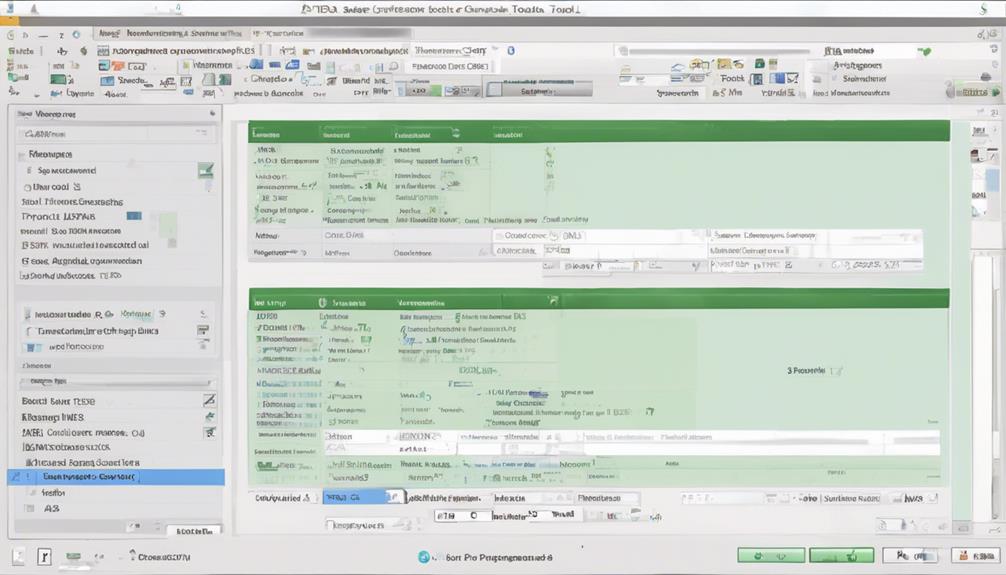When navigating the intricate landscape of bulk data formatting services, think of these ten best practices for effective bulk data formatting services as the compass guiding your journey toward precision and efficiency. From data cleaning to comprehensive reports, each practice plays a vital role in optimizing your data management processes. As you embark on this exploration of best practices, you’ll uncover the key strategies that can elevate your data formatting services to new heights of effectiveness and reliability.
Data Cleaning
When it comes to data cleaning, the process involves detecting and correcting errors in a dataset to ensure accuracy and consistency. Data standardization plays a crucial role in data cleaning by transforming data into a uniform format, making it easier to analyze and compare. By standardizing data, you eliminate inconsistencies caused by variations in how information is entered or stored.
Record deduplication is another essential aspect of data cleaning that helps in identifying and removing duplicate records within a dataset. This process ensures that each record is unique, preventing redundancy and enhancing the overall quality of the data. By deduplicating records, you streamline the dataset, making it more efficient and reliable for analysis.
Validation Checks
When it comes to validation checks in bulk data formatting services, data integrity checks are crucial for ensuring the accuracy and reliability of your data. It is essential to implement error handling protocols to address any discrepancies or inconsistencies detected during the validation process. By incorporating these measures, you can maintain the quality and consistency of your data, minimizing the risk of errors or inaccuracies in your datasets.
Data Integrity Checks
To ensure the accuracy and reliability of your data, data integrity checks, also known as validation checks, play a crucial role in the data formatting process. These checks are vital for error prevention and ensuring data validation. Data integrity checks examine the data for accuracy, completeness, and consistency. By implementing these checks, you can identify and rectify any inconsistencies or errors in the data before further processing.
Data integrity checks involve verifying that the data conforms to the specified format, rules, and standards. This process helps in maintaining data quality and integrity throughout the formatting process. Common validation checks include ensuring that data fields are within acceptable ranges, all required fields are filled, and that data types are accurate. By incorporating these checks into your data formatting services, you can minimize the risk of data inaccuracies and discrepancies.
Regularly conducting data integrity checks not only improves the quality of your data but also enhances the overall efficiency of your bulk data formatting services.
Error Handling Protocols
Data integrity checks serve as a cornerstone in maintaining the accuracy and reliability of your data. When it comes to error handling protocols in bulk data formatting services, implementing custom solutions tailored to your specific needs is crucial. Real-time monitoring is essential to swiftly identify any anomalies or discrepancies in the data formatting process. By setting up proactive alerts, you can address errors promptly before they escalate, ensuring data integrity is preserved. Continuous improvement is key in refining error handling protocols, learning from past mistakes, and enhancing the overall efficiency of your data formatting services. Regularly reviewing and updating error handling procedures based on insights gained from past errors will help minimize future occurrences. Embracing a proactive approach to error handling not only safeguards the integrity of your data but also contributes to a smoother and more streamlined bulk data formatting process.
Automated Transformation Tools
Using automated transformation tools can significantly enhance the efficiency and accuracy of bulk data formatting processes. These tools play a crucial role in streamlining tasks such as data enrichment and data standardization. Automated transformation tools can swiftly apply predefined rules to format data consistently, ensuring it meets specific standards. By automating processes like data enrichment, these tools can append missing information, correct errors, and enhance the overall quality of the dataset. Additionally, through data standardization, these tools can ensure that all data fields adhere to a uniform structure, making it easier to analyze and interpret the information.
When selecting automated transformation tools for bulk data formatting services, consider factors like the tool’s compatibility with various data formats, its ability to handle large volumes of data efficiently, and its scalability to accommodate future growth. By leveraging these tools effectively, organizations can save time, reduce errors, and improve the overall effectiveness of their data formatting processes.
Updated Data Formats
When considering updated data formats, it’s crucial to focus on the new data structure, enhanced file organization, and improved data layout. The evolution of data formats has led to more efficient ways of storing and accessing information. By understanding these advancements, you can optimize your data management processes for better functionality and productivity.
New Data Structure
Enhancing the efficiency and effectiveness of your information management system is crucial in today’s rapidly evolving digital landscape. When it comes to implementing a new data structure, it’s essential to consider the intricacies involved in schema mapping and data migration for a seamless transition.
Markdown List:
- Comprehensive Analysis: Begin by conducting a thorough analysis of your current data structure to identify gaps and areas for improvement.
- Define Clear Objectives: Clearly define the objectives you aim to achieve with the new data structure to ensure alignment with your organization’s goals.
- Collaborative Approach: Involve key stakeholders from different departments to gather diverse perspectives and insights for a holistic new data structure design.
- Testing and Iteration: Implement a robust testing process to validate the new data structure and be prepared for iterative improvements based on feedback and performance metrics.
Enhanced File Organization
For a streamlined approach to your data management system, prioritizing the organization of files in updated data formats is paramount. Customized organization and efficient categorization play a crucial role in enhancing file organization for effective bulk data formatting services. Tailoring the structure to fit the specific needs of your data sets can significantly improve accessibility and retrieval processes. By creating a customized organization system, you can ensure that information is stored logically and consistently, making it easier to locate and utilize relevant data when needed.
Efficient categorization involves grouping similar data together based on specific criteria, such as date, type, or source. This approach simplifies the navigation of files, reducing the time spent searching for particular information. Implementing a clear and efficient categorization system allows for seamless data management and enhances overall productivity. By adopting these practices, you can optimize your file organization and streamline your data formatting processes effectively.
Improved Data Layout
To achieve optimal efficiency in data management, implementing an improved data layout through updated data formats is essential. By enhancing the way data is structured and presented, you can significantly improve data visualization and user experience. Here are four key points to consider:
- Structured Data Formats: Utilize standardized formats such as CSV, JSON, or XML to ensure consistency and ease of data interpretation.
- Clear Data Hierarchy: Organize data in a logical hierarchy to facilitate better understanding and navigation for users.
- Visual Representation: Incorporate charts, graphs, and other visual aids to enhance data visualization and make complex information more accessible.
- Responsive Design: Ensure that the data layout is responsive across different devices and screen sizes to optimize the user experience.
An improved data layout not only streamlines data management processes but also enhances data visualization capabilities and improves overall user experience. By adopting updated data formats and layouts, you can elevate the efficiency and effectiveness of your bulk data formatting services.
Data Security
When considering data security for bulk data formatting services, it is imperative to implement stringent measures to safeguard sensitive information. Encryption methods play a crucial role in ensuring that data is protected both at rest and in transit. By utilizing strong encryption algorithms, such as AES or RSA, you can secure the data from unauthorized access or interception. Additionally, implementing robust data access controls is essential to limit who can view, modify, or delete the data within the formatting service.
Compliance requirements must also be adhered to when handling sensitive data. This includes following regulations like GDPR, HIPAA, or PCI DSS, depending on the nature of the information being processed. By staying compliant, you not only protect the data but also maintain trust with your clients and partners.
To prevent data breaches, regular monitoring and auditing of the formatting service are essential. By conducting security audits, you can identify and address potential vulnerabilities before they are exploited. Proactive measures like intrusion detection systems and security patches can help fortify the service against cyber threats. Remember, data security is paramount in bulk data formatting services to maintain integrity and confidentiality.
Integrated Data Sources
When it comes to integrated data sources, it’s crucial to consider data integration strategies that ensure a seamless flow of information. Ensuring compatibility among various data sources is key to streamlining data consolidation processes efficiently. By implementing effective strategies and ensuring compatibility, you can consolidate data seamlessly to enhance overall operational efficiency.
Data Integration Strategies
Integrated Data Sources are essential components of effective Data Integration Strategies. When incorporating multiple data sources into your system, it is crucial to ensure seamless integration for optimal performance. Here are key strategies to consider:
- Data Governance: Establish clear guidelines and protocols for data management to maintain data quality and consistency across integrated sources.
- Data Enrichment: Enhance the value of integrated data by adding relevant information from external sources, improving the overall quality and usefulness of the consolidated data.
- Data Mapping: Create a structured mapping process to align data fields from different sources, facilitating accurate data integration and retrieval.
- Data Synchronization: Implement mechanisms to synchronize data updates and changes across all integrated sources in real-time or at scheduled intervals to maintain data integrity.
Seamless Source Compatibility
Achieving seamless source compatibility is crucial for the successful integration of data sources in your system. Source migration involves transferring data from one system to another, which can lead to compatibility issues if not handled effectively. To ensure a smooth transition, thorough data mapping is essential. Data mapping involves matching fields from the source to the destination system, allowing for accurate data transfer and interpretation.
By implementing robust data mapping techniques, you can streamline the source migration process and minimize potential errors or data loss. This ensures that the integrated data sources work harmoniously within your system, enhancing overall efficiency and performance. Seamless source compatibility enables your system to access and utilize data from various sources seamlessly, empowering your organization with comprehensive and reliable information.
Prioritizing proper data mapping practices will facilitate a seamless integration of data sources, enabling your system to function optimally and deliver accurate insights for informed decision-making. By focusing on seamless source compatibility through effective source migration and data mapping, you can enhance the overall performance and effectiveness of your data formatting services.
Streamlined Data Consolidation
For optimal efficiency in managing diverse data sources, streamlined data consolidation plays a pivotal role. Integrating data from various sources into a centralized platform enhances data analysis and visualization capabilities, allowing for more informed decision-making processes.
Markdown List:
- Data Aggregation: By consolidating data from multiple sources, you can create a comprehensive dataset for thorough analysis.
- Data Cleansing: Streamlining data consolidation involves cleaning, organizing, and standardizing data to ensure accuracy and consistency.
- Data Integration: Combining data from different sources enables a holistic view of information, facilitating a deeper understanding of trends and patterns.
- Data Visualization: Integrated data sources support creating visual representations that aid in interpreting complex datasets and communicating insights effectively.
Efficient data consolidation streamlines workflows, reduces errors, and saves time by eliminating the need to switch between disparate systems. Leveraging integrated data sources enhances the overall data management process, fostering better decision-making and strategic planning. Through cohesive data consolidation, businesses can unlock valuable insights and drive growth.
Scaling Operations
To streamline and optimize your operations as you scale up, it is crucial to carefully assess your current processes and identify areas for improvement. Performance optimization is key to ensuring that your bulk data formatting services can handle increased data volumes efficiently. Conduct regular capacity planning exercises to anticipate growth and allocate resources effectively.
Evaluate the performance of your current systems and processes to identify bottlenecks and areas where enhancements can be made. This may involve upgrading hardware, refining software algorithms, or implementing automation tools to streamline workflows. Capacity planning should involve forecasting future data processing requirements based on historical trends and projected growth.
Implement scalable solutions that can adapt to changing demands without compromising performance. This may include cloud-based services that offer flexibility in resource allocation or modular systems that can be easily expanded. By prioritizing performance optimization and capacity planning, you can ensure that your bulk data formatting services can effectively scale up to meet the needs of your growing operations.
Processing Speed
To optimize the efficiency of your bulk data formatting services, a critical aspect to focus on is the processing speed. Performance optimization is key for ensuring timely delivery and high-quality outcomes. Here are some strategies to enhance the processing speed:
- Utilize Batch Processing: Implement batch processing techniques to handle large volumes of data more efficiently. By grouping data into batches, you can streamline the processing workflow and minimize processing time.
- Optimize Algorithms: Enhance the efficiency of your data formatting algorithms by optimizing them for speed. Utilize algorithms that are specifically designed for fast processing to reduce overall processing time.
- Leverage Parallel Processing: Take advantage of parallel processing to distribute the workload across multiple processors or cores. This can significantly improve processing speed by allowing multiple tasks to be executed simultaneously.
- Monitor and Fine-Tune: Continuously monitor the processing speed and performance of your system. Identify bottlenecks or areas for improvement and fine-tune your processes to enhance overall speed and efficiency.
Data Quality Review
Ensuring the accuracy and reliability of your data is paramount in the realm of bulk data formatting services. To achieve this, conducting a thorough data quality review is essential. Data accuracy verification involves using data profiling techniques to assess the quality of your dataset. By analyzing the data for inconsistencies, duplications, and errors, you can ensure that the information being processed is precise and reliable.
Data profiling techniques help in identifying anomalies within the dataset, such as missing values or outliers, which could impact the integrity of the final output. By scrutinizing the data at this level, you can preemptively address any issues that may arise during the formatting process. Regularly performing data quality reviews not only enhances the accuracy of your data but also improves the overall efficiency of your bulk data formatting services.
Implementing a robust data quality review process will instill confidence in your data integrity and contribute to the success of your bulk data formatting endeavors.
Comprehensive Reports
Amidst the realm of bulk data formatting services, the generation of comprehensive reports stands as a critical component in evaluating and communicating the outcomes of data processing activities. When focusing on comprehensive reports, it is essential to consider the following key aspects:
- Report Customization: Tailoring reports to specific needs allows for a more efficient analysis of processed data, ensuring that stakeholders receive the most relevant information.
- Data Visualization: Utilizing visual elements such as charts and graphs enhances the understanding of complex data sets, making it easier for users to interpret and derive insights.
- User Feedback: Incorporating feedback mechanisms enables continuous improvement of report formats and content based on user preferences and requirements.
- Performance Monitoring: Tracking key performance indicators through reports provides valuable insights into the efficiency and effectiveness of data formatting processes, facilitating informed decision-making and process optimization.
Frequently Asked Questions
How Can I Ensure Data Privacy During the Formatting Process?
To ensure data privacy during formatting, encrypt sensitive information using robust algorithms. Masking data with random characters can further protect confidentiality. Prioritize secure transmission channels and storage methods to prevent unauthorized access to sensitive data.
Are There Any Limitations on the Size of Data Sets?
When dealing with data volume, consider scalability limitations. Ensure your data sets are manageable within the system’s capacity. Verify that the bulk data formatting service can handle the size of your data sets effectively.
Can the Formatting Service Handle Non-Standard Data Formats?
Can your formatting service handle non-standard data formats? Ensure data validation is robust and customization options are flexible. It’s crucial for efficient processing. Make sure the service can adapt to your unique data requirements seamlessly.
Is There a Way to Track Changes Made to the Data?
To maintain data integrity, you should implement version control for tracking changes made to the data. This ensures accountability and allows you to revert to previous versions if needed. Stay organized and safeguard your data.
What Level of Technical Support Is Available for Users?
You have access to top-notch technical support, ensuring smooth operations. Expert assistance is just a call away, guiding you through any data security concerns or formatting challenges. Stay confident with reliable help at your fingertips.



